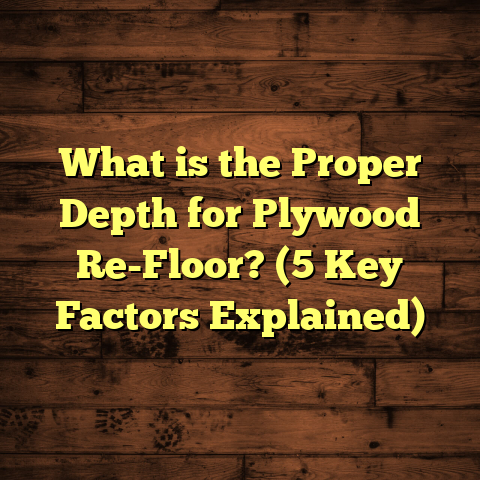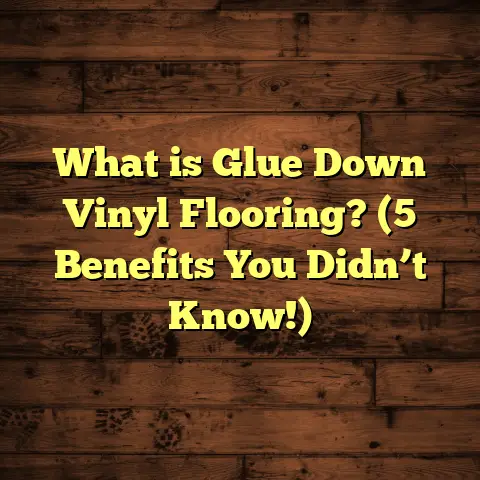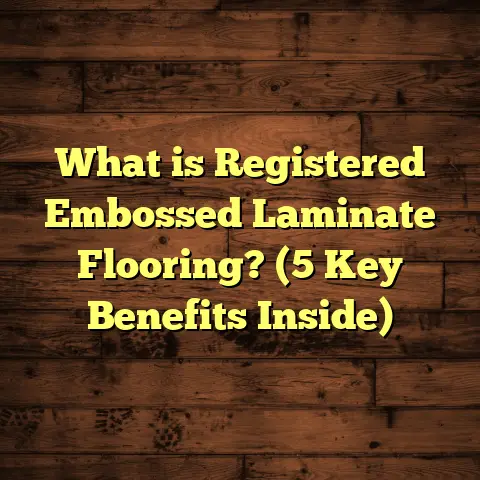What is a Finish Floor? (5 Key Benefits for Your Space)
Have you ever stepped into a room and felt like something just wasn’t right about the floor? Maybe it felt cold, uneven, or just plain uninviting. I’ve come across this feeling a lot in my years working with homes and commercial spaces. People often overlook how much the finish floor shapes the entire room’s vibe and function. What exactly is a finish floor, though? And why should you care about it as much as I do? Let me walk you through everything I know—from the basics to some insider tips that could change how you think about your floors forever.
What Is a Finish Floor?
At its core, a finish floor is the very last layer of flooring installed in any space—the surface you actually see and walk on every day. It’s sometimes called the “wear layer” because it takes all the abuse from foot traffic, furniture movement, spills, and even pets. This isn’t just a decorative piece; it has to be durable enough to last years while still looking good.
The finish floor sits on top of several other layers. Usually, there’s a subfloor beneath—made from plywood or concrete—that provides structural support. The subfloor is critical to keeping everything stable, but it’s the finish floor that delivers the look, feel, and usability we notice immediately.
Why Do We Need a Finish Floor?
Imagine if you had just a bare concrete slab in your living room. Sure, it would be functional but cold, hard, and not exactly welcoming. Now imagine walking on smooth hardwood or soft carpet instead—that finish floor makes the space feel alive.
Beyond comfort and style, the finish floor protects the subfloor underneath from damage and moisture. It also plays a big role in acoustics—hard floors sound different than carpeted ones—and even impacts thermal comfort by insulating or conducting heat.
Manufacturing Processes & Technical Details
Different finish floors are made entirely differently, with unique processes that affect their performance and lifespan.
Hardwood Flooring
Solid hardwood comes from milling thick planks from a single piece of tree trunk. The wood is dried carefully to reduce moisture (usually to 6-9% content), which prevents warping later. Then it’s planed smooth and sanded to perfection before factory finishes are applied—often multiple coats of polyurethane to protect against scratches and water.
Engineered Hardwood
This type uses a thin veneer of real wood on top of plywood or fiberboard layers glued crosswise. This layered construction helps reduce expansion and contraction with humidity changes—a big deal in basements or humid climates. It’s finished similarly to solid wood but tends to be thinner, usually 3-4mm of hardwood veneer.
Vinyl Flooring
Vinyl starts as polyvinyl chloride (PVC) resin mixed with plasticizers for flexibility. It’s then roll-pressed into sheets or tiles. Patterns are printed onto the surface using high-definition digital printers. The final step is adding a transparent wear layer, often infused with ceramic beads or urethane for scratch resistance.
Tile Flooring
Tiles are made by firing natural clay or porcelain at temperatures above 1200°C. This process vitrifies the material—making it dense, hard, and waterproof. Tiles can be glazed to add color and texture or left unglazed for slip resistance.
Each material has specifications such as thickness (2mm for vinyl up to 20mm+ for hardwood), wear layer durability (0.1mm for budget vinyl to 6mm for commercial-grade), and hardness measured by Janka (wood) or Mohs scale (stone).
How I Learned to Appreciate Finish Floors
When I first got into flooring work over 15 years ago, I didn’t realize how much the finish floor mattered beyond aesthetics. Early on, I took on a project where the client wanted cheap laminate flooring. It looked great initially but started peeling and bubbling after six months due to poor moisture resistance. That taught me that choosing the wrong finish floor can lead to frustration and extra costs.
In contrast, I once installed reclaimed oak hardwood in a family home with kids and dogs. The floor developed beautiful character marks over time but stayed sturdy and functional. The owners loved how their finish floor grew with their family’s story—something you just don’t get with cheap vinyl.
These experiences taught me that the finish floor is really about balancing beauty, durability, and lifestyle needs.
5 Key Benefits of Having a Good Finish Floor in Your Space
Let’s break down why having the right finish floor matters so much:
1. Durability That Suits Your Everyday Life
Not all floors are built equally. A high-quality finish floor can last decades if properly maintained. Hardwood floors with tough finishes like aluminum oxide resist scratches far better than untreated wood.
According to data from the National Wood Flooring Association (NWFA), solid hardwood floors can last 30-100 years depending on species and care. Engineered hardwood tends to last 20-30 years on average but handles moisture better.
Vinyl flooring is known for its water resistance and resilience under heavy traffic. For example, luxury vinyl tile (LVT) has a wear layer thickness ranging from 12 mils (light commercial) to 40 mils (heavy commercial), making it suitable for kitchens, bathrooms, and even commercial spaces.
If you’re thinking tiles are fragile, consider porcelain tiles fired at extremely high temperatures—they’re denser and less porous than ceramic tiles, reducing chipping and cracking risks.
I remember a restaurant client who switched from carpet to commercial-grade vinyl tiles after constant wear issues. The new finish floor handled spills and foot traffic without damage even after two years.
2. Aesthetic Appeal & Design Versatility
The finish floor sets the mood for your entire room. You can go rustic with reclaimed wood planks or modern with sleek polished concrete-look tiles.
Advances in manufacturing mean vinyl and laminate floors can replicate natural materials almost perfectly—even fooling guests who think they’re real wood or stone.
I once worked with a client who wanted eco-friendly options with style. We opted for bamboo flooring—a fast-growing grass harvested sustainably but finished to look like exotic hardwood. The result was stunning and unique.
Colors, textures, plank widths—all these choices let you personalize your space fully.
3. Comfort Underfoot & Safety Considerations
How often do you think about how your floor feels?
Carpet obviously adds warmth and softness but can trap dust allergens and stains easily.
Cork flooring offers natural cushioning and thermal insulation while being hypoallergenic—perfect for bedrooms or nurseries.
Hard surfaces like tile or stone can feel cold unless paired with radiant heating systems—something I’ve seen become increasingly popular in colder climates.
Safety is another aspect—matte finishes reduce slips compared to glossy floors. Textured tiles offer grip in wet areas like bathrooms or poolsides.
One elderly client switched from polished marble to textured porcelain tiles after several close calls slipping; it made their home safer without sacrificing style.
4. Maintenance Made Manageable
I always ask clients: “How much time do you want to spend on cleaning?”
Some finish floors need annual refinishing—like solid hardwood with polyurethane coatings—to restore shine and protection.
Vinyl and laminate floors usually require just regular sweeping and damp mopping with mild cleaners.
Stone tiles may need sealing every couple of years to prevent staining but otherwise last easily decades.
A study by HomeAdvisor showed that homeowners spend nearly 10 hours monthly cleaning floors—so picking low-maintenance finishes can save serious time over years.
I recall one family who switched from wall-to-wall carpet to engineered hardwood because they found pet hair impossible to clean out of carpet fibers.
5. Boosting Property Value
Homes with high-quality finish floors tend to sell faster and at better prices.
Zillow research shows homes with hardwood floors can see resale price increases between 2-5%, depending on location and condition.
I’ve helped many flippers who replaced dated carpets or worn vinyl with fresh hardwood or tile—and those projects almost always recouped costs through higher sale prices.
Even renters appreciate durable floors that look good—landlords installing vinyl plank flooring report fewer tenant complaints about wear or damage.
Digging Deeper: Material Breakdown & Insights
Here’s a closer look at common finish floors—from my firsthand experience combined with industry data:
Hardwood Floors
Hardwood is timeless—but not always practical everywhere.
- Pros: Long lifespan, repairable by sanding/refinishing multiple times
- Cons: Sensitive to moisture, can dent/scratch
- Specs: Typically 3/4 inch thick; Janka hardness varies by species (Oak ~1360; Hickory ~1820)
- Manufacturing: Kiln dried, surfaced smooth, coated with polyurethane or oil-based finishes
When installing hardwood in humid areas like basements, engineered hardwood is usually safer due to dimensional stability.
Engineered Hardwood
Great option where moisture is an issue.
- Pros: Stability against humidity, thinner planks possible
- Cons: Limited refinishing due to thin veneer
- Specs: Veneer thickness usually 2-4mm; total thickness 7-15mm
- Manufacturing: Multiple wood layers glued cross-grain; finished like solid wood
Vinyl Flooring
Versatile and budget-friendly.
- Pros: Water-resistant, low maintenance, wide design options
- Cons: Can off-gas VOCs if low quality; less “luxury” feel than real wood
- Specs: Thickness from 2mm (sheet vinyl) up to 8mm+ (LVT); wear layers 0.1–0.4mm
- Manufacturing: PVC resin mixed with plasticizers; printed surface patterns; coated wear layer
Laminate Flooring
An affordable alternative mimicking wood.
- Pros: Scratch resistant, easy installation via click-lock systems
- Cons: Susceptible to water damage if seams aren’t tight
- Specs: Thickness from 6mm-12mm; wear layers typically 0.2–0.6mm
- Manufacturing: Fiberboard core topped with photographic layer + melamine overlay
Tile Flooring
Durable but cold/hard.
- Pros: Waterproof, stain resistant, great for wet rooms
- Cons: Cold underfoot; grout requires maintenance
- Specs: Thickness varies between 8–12mm; porcelain denser than ceramic
- Manufacturing: Fired clay/porcelain at high temperatures; glazing adds color + protection
Carpet
Softness unmatched but higher upkeep.
- Pros: Warmth, sound insulation
- Cons: Stains easily; traps allergens; shorter lifespan (5–15 years)
- Specs: Pile height varies; synthetic fibers dominate market (nylon, polyester)
- Manufacturing: Fibers tufted/knotted into backing material; dyed/finished
My Personal Story: When Finish Floor Choice Made All the Difference
Let me tell you about a project that really opened my eyes about the power of finish floors.
I was hired by a young couple renovating their first home—a charming cottage near the coast. They wanted a cozy feel downstairs but struggled deciding between carpet or hardwood for their living area.
They loved how hardwood looked but worried about sand tracked inside from beach visits ruining the floor quickly.
After discussing pros and cons—and showing them samples—we chose engineered hardwood with a tough aluminum oxide finish plus area rugs near entries for dirt control.
Two years later, they told me their decision was perfect: the floors still look great despite kids’ toys, pets, and sandy feet coming in daily.
This project showed me how no single finish floor fits all—matching materials to lifestyle is key.
How To Choose Your Finish Floor: My Step-by-Step Guide
- Assess Your Space & Usage
Think about traffic levels, moisture exposure (bathrooms? basements?), pets/kids presence. - Set Your Budget
Include installation + maintenance costs over time—not just upfront price. - Look at Samples & Test Comfort
Feel textures underfoot; check finishes for slip resistance if needed. - Consider Longevity & Maintenance
Will you refinish hardwood? Seal tile grout? Clean carpets regularly? - Check Environmental Impact
Some materials have higher VOC emissions; others are sustainably sourced like bamboo or cork. - Consult Pros & Use Tools
Online calculators like FloorTally help estimate costs based on local labor/material prices—saving time and surprises down the road.
More Data & Research Insights
I recently reviewed industry reports from several sources:
- According to the U.S. Forest Products Laboratory, engineered hardwood sales have grown by over 40% in the last decade due to their moisture resistance.
- The Resilient Floor Covering Institute reports vinyl flooring now accounts for nearly 25% of U.S. residential flooring sales.
- A survey from Houzz showed nearly 60% of homeowners prioritize durability over style when selecting flooring.
- Real estate analytics firm CoreLogic found homes with hardwood floors sold on average 17 days faster than comparable homes without them.
- Carpet Institute research indicates untreated carpets can harbor dust mites contributing to allergies—important for families considering carpet options.
Addressing Common Concerns About Finish Floors
Q: Are finish floors expensive?
A: Initial prices vary widely—from budget vinyl at $2/sq.ft up to premium hardwood at $15+/sq.ft installed—but long-term value depends on durability and maintenance costs too.
Q: Can I install finish flooring myself?
A: Some types like click-lock laminate or vinyl plank are DIY friendly; others such as tile or hardwood usually require pros for best results due to complex prep/workmanship demands.
Q: What about allergy issues?
A: Hard surfaces like tile or vinyl don’t trap allergens as carpets do—great choice if allergies are a concern.
Q: How do I maintain my finish floor?
A: Regular sweeping/dusting is universal advice; avoid harsh chemicals; follow manufacturer’s care instructions especially for sealing/refinishing schedules.
Final Thoughts From Someone Who’s Seen It All
Over thousands of projects, I’ve learned that your finish floor isn’t just something you choose once and forget—it’s part of your daily life’s comfort zone. It affects how your home looks, feels, smells (yes!), and functions every minute you spend inside it.
Investing time understanding what finish floor suits your needs pays off in happier living spaces that last decades without headaches or costly repairs down the line.
So next time you’re staring at your old carpet or scratched wood wondering if it’s time for a change—think about what your finish floor says about your lifestyle—and what it could say if chosen right.
What questions do you have about your floor? I’m always happy to share what I’ve learned from my years walking thousands of square feet underfoot!





